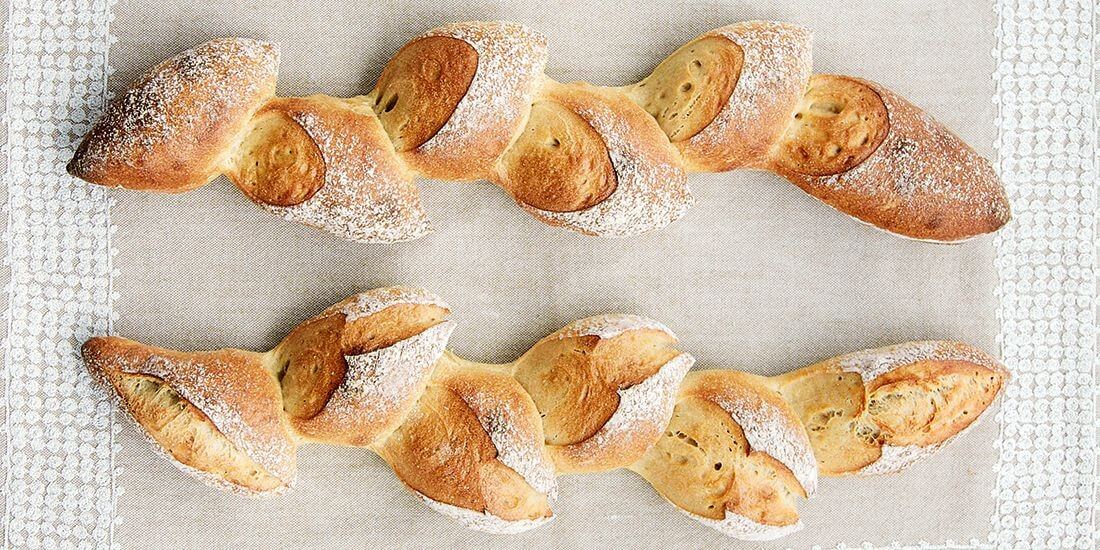

Bake a fancy epi loaf to impress your guests
The simple pleasure of cracking open a fresh loaf of bread and devouring a warm slice smeared with butter can only be heightened when that doughy creation was crafted by your very own hands. Parisian master baker Éric Kayser is no stranger to this feeling, and now he’s sharing his secrets with English-speaking bread fiends via The Larousse Book of Bread, which is available in English for the first time. Brought to you by the publishers of the Larousse culinary encyclopaedia, the tome serves up 80 recipes with variations and step-by-step photography. Whether you’re pining for a traditional cob, a speciality rye, an organic sourdough or perhaps even a sweet brioche, The Larousse Book of Bread has you covered. This recipe for fancy epi loaves is sure to impress both eyes and stomachs.
INGREDIENTS
4 cups all-purpose (plain) flour, plus extra for dusting
Scant 1 ⅓ cups water at 20°c
Scant ½ cup liquid sourdough starter (or 3 tablespoons dry sourdough starter)
1 teaspoon fresh baker’s yeast, crumbled
2 teaspoons salt
TO MAKE
Kneading in a stand mixer
Put the flour and water in the bowl. Knead with the dough hook for five minutes at low speed. Remove the bowl from the mixer and cover with a damp cloth. Leave to rest for one hour, then add the starter, fresh yeast, and salt. Knead for four minutes at low speed, then for seven minutes at high speed.
Kneading by hand
Put the flour on a work surface or in a mixing bowl and make a large well in the centre. Pour in two-thirds of the water and mix until all the flour has been incorporated. Leave to rest for one hour, covered with a damp cloth, then incorporate the rest of the water, the starter, baker’s yeast, and salt. Knead the dough until it becomes smooth and elastic.
Shape the dough into a ball and cover with a damp cloth. Leave to rise for one hour and 30 minutes. It will have increased in volume by the end of the rising time.
Dust the work surface. To make three epis, divide the dough into six equal pieces. Fold each piece over on itself, pulling gently to stretch into a longish log. Leave to rest for 30 minutes under a damp cloth.
Working with one piece of dough at a time, use the palm of your hand to flatten it gently. With the long side facing you, fold in a third towards the centre and press it gently with the heel of your hand. Swivel the dough 180 degrees. Fold in the other long edge so that it overlaps in the centre and press again. Fold one half on top of the other, and seal the edges together with the heel of your hand. With lightly floured hands, roll the loaf out to around 50 cm, tapering the ends. Shape the other loaves in the same way.
Place three shaped pieces of dough, seams underneath, on a baking sheet lined with parchment (baking) paper.
Cover with a damp cloth and leave to proof for one hour and 30 minutes.
Place another baking sheet on the bottom shelf of the oven and preheat to 230°c.
Flour the blades of a pair of scissors. Using the scissors, held horizontally and at a slight angle, make five cuts along the dough at regular intervals, to create six ‘wheat grains’.
Use your fingers to gently twist the ‘grains’ alternately to the right and left.
Just before putting the loaves in the oven, pour a scant ¼ cup of water onto the preheated baking sheet.
Bake for around 20 minutes.
Remove from the oven and leave to cool on a wire rack.
Recipe and images from The Larousse Book of Bread by Éric Kayser. Published by Phaidon.
The Stumble Guide is our comprehensive Gold Coast dining guide with more than 870 places to eat, drink, shop and play.
